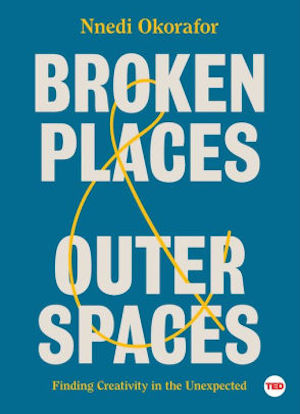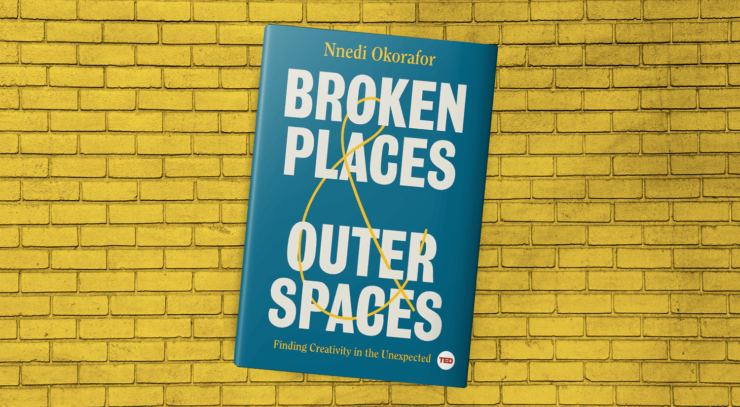Following her compelling talk, “Scifi stories that imagine a future Africa” (2017), the TED Books series now presents Nnedi Okorafor’s Broken Places & Outer Spaces. Part memoir, part craft text, the book is a personal narrative of the route Okorafor took to arrive at her career as a writer of science fiction. In the TED talk, she discusses the roots and influences of her science fiction as an Africanfuturist and reads selections from Binti and Lagoon; in this companion book her approach is more personal, focusing primarily on the life-changing experience of a scoliosis surgery that left her—a college athlete and track star—paralyzed.
Confined to her hospital room and laboring under the emotional and physical pain of her recovery, Okorafor first experiences her creative awakening—a process that comes in fits and starts, as does her rehabilitation. As she reflects on this experience in intense, intimate detail over the course of the book, she also explores what it means to be broken and rebuilt, to be made into something greater than the original form: a cyborg, a futurist, an artist.
As Okorafor says in the introduction, regarding kintsugi as an artform that repairs “the total object”:
…you transform what you have fixed into something more beautiful than it previously was. This is the philosophy that I came to understand was central to my life. Because in order to really live life, you must live life. And that is rarely achieved without cracks along the way. There is often a sentiment that we must remain new, unscathed, unscarred, but in order to do this, you must never leave home, never experience, never risk or be harmed, and thus never grow.
This emphasis on repair and transformation after a breakage is the central conceit of Okorafor’s argument in Broken Places & Outer Spaces. Her path to the writing career that has brought us, her audience, such amazing novels as Who Fears Death involved a great Breaking—the spinal surgery that left her temporarily paralyzed and with permanent damage to her proprioception—and a period of recovery. As she narrates her own story for the reader she also brings in examples of other artists and their traumas, how embracing the whole self, pain and all, was important to their creative processes.
However, on that note, I do have reservations about the approach the text sometimes begins to lean toward regarding the relationship between pain and art. In discussions of Frida Kahlo and Mary Shelley, as well as her own journey through trauma to become a writer, Okorafor occasionally shifts the conversational frame to center pain as the progenitor and source of art (as opposed to art as the process that ameliorates and communicates through pain toward survival, for example). The implication that makes me uneasy is that suffering is a requirement for artists to produce their finest work—a concept that has, historically, done more harm than good particularly in the realm of mental health.
But even within the discomfort I’m expressing there exists a delicate balance, since the statement that a person would not exist in their current state as their current self without their trauma is also accurate. The art that they’ve made as a result of their breaking would not exist without it. However: what about the art that might’ve been made in the absence of trauma? We’ll never know what that might’ve been, either. Pain does not always equal growth—sometimes it’s just pain, just breaking, and sometimes it’s unfixable. Sometimes pain kills art. I’m thinking, in this particular moment, of folks like Joanna Russ whose careers did suffer as a result of physical ailment.
Buy the Book


Broken Places & Outer Spaces
On the level of memoir, though, that hint of discomfort is moot because Okorafor is speaking to her own lived experiences. This book is her personal story, and that’s also important to the context. As a regular reader it’s certainly meaningful to be gifted insight into her artistic development and her theories of creativity. Furthermore, the thesis statement of the book—offering “a philosophy that positions our toughest experiences not as barriers, but as doorways […] to us becoming our truest selves”—has a hopeful ring that I do appreciate, suggesting that our existence in this moment is a collection of opportunities we should do our best to embrace. Life experience, even or especially if it is painful, is indeed unique to each person.
Centering the strength of healing over the valorization of pain—which is, by and large, what the book does do—also allows for that sense of fracture that lets the light in and so forth. That approach is in fact one of significant optimism. Okorafor experienced a terrible ordeal and, as she argues, without it would not have written her work as it stands. However, she also closes the book by emphasizing that her art is made of more than pain—it’s also shaped and created by familial trips to Nigeria, her experiences there, and her shifting understanding of her family’s stories as she became an adult. The final chapters create a more holistic sense of her argument regarding finding the creative catalyst in one’s experiences, not just of pain but also family, time, magic, travel, and more.
Overall, Broken Places & Outer Spaces contains a quietly effective power in its insistence on flexible strengths and the drive to create, on the mind and the body and the self as inextricably intertwined. Okorafor paints an emotional portrait of her paralysis as well as the slow process of her rehabilitation to a cyborg reality—while also offering intellectual and philosophical explorations of disability that emphasize futurity, not just surviving but thriving. The closing imagery, after all, is of her falling free into the water of the ocean. It’s a striking close to a conversational and intimate piece of craft-memoir-oriented nonfiction that encourages the reader to, as the subtitle says, find “creativity in the unexpected” circumstances of their life.
Broken Places & Outer Spaces is available from Simon & Schuster.
Lee Mandelo is a writer, critic, and editor whose primary fields of interest are speculative fiction and queer literature, especially when the two coincide. They have two books out, Beyond Binary: Genderqueer and Sexually Fluid Speculative Fiction and We Wuz Pushed: On Joanna Russ and Radical Truth-telling, and in the past have edited for publications like Strange Horizons Magazine. Other work has been featured in magazines such as Stone Telling, Clarkesworld, Apex, and Ideomancer.










